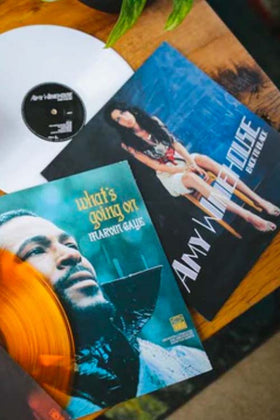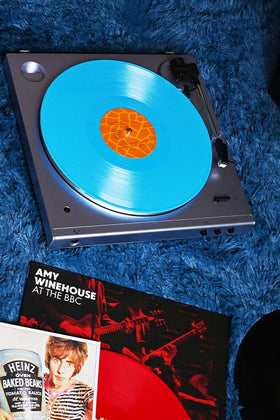Types of Vinyl Records: The Vinyl Lover's Ultimate Guide
Even though they’ve been around for a long time, there are still only a few types of vinyl records available for collectors to get their hands on. Like any collector’s item, it’s important to identify records by category to describe them and find the ones you’re looking for.
The types of records can be classified by their size, weight, playback speed, as well as by how much music they can hold. There’s a lot of descriptive overlap. The same record can be referred to by its size or its playback speed. However, there are a few ways to differentiate records from each other and a few general rules for how certain records are always referred to.
In this article, we’ll take a look at records and the ways they’re categorized so that you’ll have everything you need as a vinyl lover to expand your collection like an expert.
Key Term: RPM
Playback speed is measured in revolutions per minute, or RPM. RPM is the number of times a record makes a complete spin in one minute. Larger records take longer to turn than small ones do, so RPM can correlate with record size — but not always!
Two RPMs are widely available now; 33 ⅓ and 45 revolutions per minute. 45 RPM records have better sound quality than 33 ⅓ RPM records do. This is because they have more grooves for the turntable’s needle to read and can express more complex and nuanced sound patterns as a result. 33 ⅓ records are more cost-effective and good for products like audiobooks and language-learning courses that don’t necessarily require a nuanced audio profile.
You may occasionally find 78 RPM records available if you're into very old records. They were discontinued in 1959 and only held about 5 minutes of sound on each side, so they’re hard to find and play on newer turntables. They’re very fragile, and unless you’re a serious collector, you’re unlikely to have any 78s.
Key Term: Record Weight
Vinyl records are weighed in grams. Typically, they weigh between 120 and 140 grams.
Some records weigh in at 160 to 180 grams. These records weigh more simply because they are thicker. Thicker records are thought to have clearer bass sounds and less audio noise, but there’s a lot of debate about whether or not this is true.
Despite the debate, 180-gram records are often collected by serious audiophiles who are willing to pay extra for a better sound and more durable vinyl to add to their stash.
Types of Records: By Size
The easiest way for newbies to categorize their records is by size. Knowing whether a record is bigger or smaller is a simple visual cue. It’s easy to remember that bigger records hold more sound, usually at better sound quality.
Let’s dig into the details about each available size of record you’re likely to find in vinyl shops today.
12-Inch LPs
12-inch LP (long play) records hold full-length albums. That’s only about 25 minutes of music on each side of a record, so you’ll have a set of several pieces of vinyl for longer albums.
These are the biggest records available, both in terms of physical size and the amount of music they hold. They usually play at 33 ⅓ RPM, but finding a 45 RPM 12-inch LP is not unusual. The reason for the difference in RPM is the sound quality. 45 RPM records sound better, and as a result, are better collector’s items for audiophiles.
12-Inch Singles
12-inch singles are the same size as the LPs but only hold a single song on each side.
Because there are only two songs on a 12-inch single, they’re referred to as the A-side and B-side singles. Usually, the A-side is the song the artist hopes will become a hit, and the B-side is an album cut that shows off an aspect of their artistry or technical brilliance for the fans.
When DJs play records on turntables, it’s usually a 12-inch single due to its easy index (there’s only one song to find and play) and the higher sound quality that 12-inch 45 RPM records have.
7-Inch Singles
7-inch singles usually play at 45 RPM. In fact, 7-inch records are commonly called “45s”. They have a smaller circumference than 12-inch records, but the hole in the middle of the record is bigger. Turntables come with adapters to adjust the spindle to the difference in size so that the records still play smoothly.
Like 12-inch singles, 7-inch singles only hold two songs — an A and B-side single, one on each side of the record. Historically, 7-inch vinyl was used for promotional singles and can still be found as part of special promotional campaigns from artists who are feeling nostalgic.
10-Inch Records
There are also 10-inch records, which can hold almost as much as an LP. Originally, several 10-inch records would be used to release long pop albums.
However, the sound quality of 12-inch records is generally much better than 10-inch records, so the latter is becoming harder and harder to find. Most new vinyl, whether albums or singles, is pressed on 12-inch records. 10-inch records aren’t obsolete like 78 RPM records are, but they aren’t popular because other records can do the same thing with more storage space and higher sound quality.
Unusual Types of Records
There are a few unusual types of records that you can find when you’re crate-digging at your local store. They’re not as common as the types we’ve already mentioned, but they’re worth knowing a little bit about in case you stumble upon them.
Colored Records
Occasionally, you’ll be able to find colored records in stores. While most records of any size or recording length are made of black vinyl, sometimes vinyl records can be produced in bright colors, like orange or blue. This is usually done for aesthetics or promotional purposes.
Some sound purists dislike colored vinyl because they believe it affects the sound of the music. However, there’s no concrete proof that colored vinyl records sound any different than regular black ones. Because of this, more colored vinyl may be released as a way to make records stand out and promote artists more heavily. Colored records also have higher resale values for collectors because some designs are unique or limited.
Picture Records
Picture records are another interesting aesthetic variety of vinyl. These records have pictures either painted on or integrated into the vinyl of the record. Because the pigment used to create the pictures interferes directly with the vinyl grooves, picture records generally have lower sound quality than plain black and colored vinyl.
EPs
EPs, or extended play records, hold more music than singles but less than LPs. Both 33 ⅓ and 45 RPM EPs are available. They can also be 7, 12, or even 10-inch records.
EP refers entirely to the length of the music recorded, not to the record that they are pressed on. EPs are usually less expensive than LPs, so they’re a good choice for artists who want to release shorter works or extended singles.
Knowing the Types of Records Can Help You Build Your Collection
It might seem a little challenging at first, but knowing the types of vinyl records can help you build your collection with your priorities in mind.
If you’re a true audiophile and quality of sound is the most important thing about vinyl for you, focus on finding 45 RPM records, no matter the physical size or amount of songs stored on them. If you’re someone who prefers to collect full albums or an artist's entire catalog, focus on LPs, which are usually 12-inch records, but occasionally 10-inch records too.
If you’re interested in owning rarities from an artist's catalog, look into gathering 7-inch singles with unusual B-sides. If you’re interested in owning physical rarities, look for colored vinyl, picture records, or 78s — but be aware that the latter two won’t be playable, for the most part.
There are many kinds of vinyl records, each with its own unique charm for collectors and vinyl lovers. If you’re interested in collecting records, take a look at our guide to buying used vinyl, where you can find tips on how to find all of the different types of records from this article.
Sources
Vinyl Record Types, Sizes & Speeds | What Is Vinyl?
Definition of audiophile | PCMag
Promotional Tools: What Is the EP Music Release Format? | The Blanace Careers



